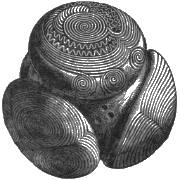Canmore Site 40371: BUTE, GLECKNABAE - NORTH BUTE - CHAMBERED CAIRN (NEOLITHIC), SHELL MIDDEN (MESOLITHIC), SHORT CIST (BRONZE AGE)
Description
| Site Name | BUTE, GLECKNABAE |
|---|---|
| Other Name(s) | n/a |
| Site Number | NS06NW 8 |
| Broad Class | AGRICULTURE AND SUBSISTENCE, MONUMENT (BY FORM), RELIGIOUS RITUAL AND FUNERARY, DOMESTIC |
| Site Type(s) | CHAMBERED CAIRN (NEOLITHIC), SHELL MIDDEN (MESOLITHIC), SHORT CIST (BRONZE AGE) |
| NGR | NS 00745 68263 |
| NGR accuracy | NGR given to the nearest 1m |
| Local Authority | ARGYLL AND BUTE |
| Parish | NORTH BUTE |
| Record created | 1988-07-04 |
| Last updated | 2010-05-04 |
Archaeology Notes
NS06NW 8 00745 68263.
This place has been examined by Dr Schoular, Dublin, Mr McAdam [probably Robert Shipboy McAdam 1808-1895], Belfast and the Rev. Mr McBride, Kamesburgh, and some stone coffins and human bones were found; the two former gentlemen wished to test some passages in the Annals of Ulster, or the 'Four Masters', relative to three brothers called McGillichiaran, who left Ireland at an early period, and settled at Glecknabae. The three brothers appear to have been buried here, and possibly their offspring. The Sharps of the West Highlands have descended from one of th brothers.
OS Name Book Buteshire No.5, p.11 c.1864
(NS 0073 6825) Chambered Cairn (NR)
OS 6" map (1957)
This Clyde-type chambered cairn, situated in a sloping field between 50ft and 100ft OD, has been much robbed and disturbed, and now appears as a roughly oval, grass-grown stony mound, about 60ft by 30ft and about 4ft high, with the tops of a few constructional stones just visible. Its edge is defined by the limit of ploughing.
About 1900, the cairn was reduced by about a third on the S side, suggesting that it was originally round in plan, some 55ft in diameter. Bryce (1904) excavating in 1903, found that the cairn overlay a shell midden, one to two feet deep, covering an area 35ft by 25ft in the middle of the cairn and extending under the NW chamber. Two small chambers and a short cist, the latter still complete, were found. The chambers contained burnt bone, with a few fragments of unburnt bone (now in the NMAS, acc no. EO 290) in the N chamber, while the secondary cist contained the remains of an inhumation. Artefacts from the chambers, now in the NMAS (acc no. EO 274-289) include pieces of round-bottomed bowls, beaker fragments, flint scraper, flint etc. A vessel 'like a flower pot' apparently simply embedded in the cairn, found by the farmer before Bryce's excavation, is now lost, as is the fragment of a large quern, with a perforation, found among the stones filling the SE chamber. Lacaille suggests that the shell midden noted by Bryce may indicate late Larnian occupation.
A S Henshall 1972; D L Clarke 1970; A D Lacaille 1954
A round cairn with double chamber and a cist, covered by a capstone, on the N perimeter.
Information from K A Steer 17 July 1975.
NS 0075 6826. A chambered cairn as planned and described in the previous information. The short cist is still intact, but only two end slabs of the central chamber can be seen. The easterly chamber has been totally destroyed.
Surveyed at 1/10,000.
Visited by OS (BS) 20 October 1976.
This chambered cairn is situated on a gentle SW-facing slope in a pasture field 270m SE of Glecknabae farmsteading (NS06NW 63). The surface of the grass-grown cairn has been damaged by animal scrapes but the remains of the cist on the W side are still visible.
Visited by RCAHMS (AGCH, GG) 16 March 2009.
Identifiers and Links to Other Records
This record has no links! Would you like to help?
| Identifier / External Link | Linked Record | Status | Comment |
|---|---|---|---|
| Canmore Site Number (legacy): NS06NW 8 | No linked record |
This area is visible only to logged in users.
